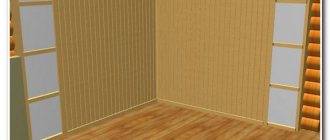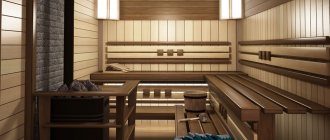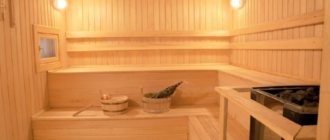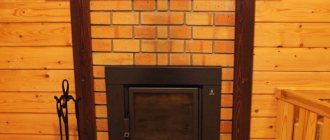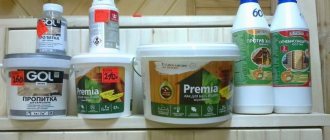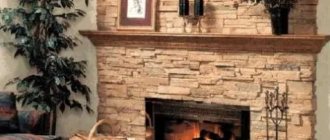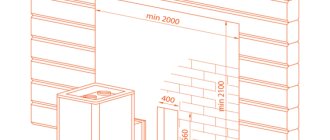When firing a stove or igniting a fireplace, their body becomes very hot, transferring this temperature to the surrounding surfaces. In accordance with fire safety techniques, it is necessary to insulate the furnace body from adjacent surfaces using fire-resistant materials if a safe distance is not maintained. This is a distance equal to 30 cm for a brick stove, more than 1 meter for a metal stove and 70 cm for a metal-lined stove. If it is impossible to dissipate heat naturally in a room (especially a small area), fire-resistant materials are used for the walls around the stoves.
Technology for installing refractory materials for finishing walls around the stove
It is necessary to create heat-insulating structures or apply coatings of this type when the distance from the walls of stoves or fireplaces to the protected surface is less than the established standards. They are as follows: from the walls to the surface of the stove made of brick there should be at least 32 centimeters, to the heating device made of metal - at least a meter, and to lined metal fireboxes - at least 70 centimeters.
- Reflecting heat into the room. As a rule, this role is played by a stainless steel sheet or a special heat-insulating screen made of the same factory-made stainless steel.
- Protecting the surface due to its characteristics - physical and chemical. There is more choice here - fire-resistant gypsum plasterboard, mineralite, glass-magnesium sheet, various ceramics and porcelain stoneware slabs.
Both finishing options are quite effective, but mixed-type structures are often used, including both a reflective coating and an internal fire-resistant layer. These are the solutions that are used most often and provide the highest degree of insulation.
You can take a different route and build a protective screen around a heat source made of stone or brick. However, such structures are quite cumbersome and require some mason skills for construction and quite a lot of time for installation. Therefore, much more often, any sheet non-combustible material from those discussed above is used to decorate the walls behind the stove.
A sufficient degree of insulation and a very beautiful appearance can be ensured by decorating the surface with terracotta or ceramic tiles. However, in this case, the firebox will have to be placed at a distance of at least 30 centimeters from the walls. This is not particularly much, but in some situations it can become a problem.
To prevent such a nuisance as a fire from happening, heat-resistant materials are used to decorate the walls near the stove. Any such heat source not only heats the air in the room, but also heats up itself very strongly and therefore, the surrounding partitions can easily catch fire. In our case, these are walls and floors.
Fireproof sheet materials for stoves and fireplaces
To equip heating structures, fireproof sheet materials for fireplaces and stoves are also needed, since combustion devices heat up to high temperatures during operation.
Only then are they able to transfer heat to the surrounding space. At the same time, surfaces are heated, especially walls that are located closest to the stove or fireplace. And to avoid fire, screens and cladding are also made from such composites, which should also have an aesthetic appearance.
Screens can be side or front. With their help, the temperature on the outer surfaces of combustion systems is reduced to 100 ° C, which improves fire safety. Installation of convenient protective screens is simple and is carried out by attaching them to the floor using special legs.
Side protective screen
To ensure the fireproof condition of the room, you need to wisely select the material for covering the walls near which the heating structure is located.
And vermiculite panels are ranked among the most effective OLM. Moreover, such slabs are used to ensure fire safety in various premises, including enterprises in the nuclear and oil refining industries.
Among the advantages of fire-resistant vermiculite boards are:
- environmental friendliness;
- fire resistance;
- thermal insulation;
- sound insulation;
- aesthetic appearance, which allows them to be used in prominent places.
Vermiculite panels, due to their excellent performance qualities, can be used in many areas.
Scheme of thermal protection of a wall and fireplace lining with a vermiculite slab
- For thermal insulation of fireplaces and stoves.
- For fire protection of structures made of different materials.
- To ensure that various objects can withstand fire hazards.
- For guaranteed fire resistance of various indoor items, including stoves and fireplaces.
Vermiculite boards, as representatives of OLM, are installed simply and quickly and do not require professional training. Processing them on all sides of a stove or fireplace ensures protection of the room from the effects of fire and high temperatures, and therefore such fire-resistant sheet materials are optimal in solving the problem associated with the fire safety of the room.
If you have a stove, then you should definitely know about fireproof materials for the walls around the stoves. This is the key to long-term operation of the stove itself and protection of your home from high temperatures when the stove is operating.
During the process of heating a stove or igniting a fireplace, the body becomes very hot and gives off heat to surrounding objects. According to fire safety requirements, it is necessary to insulate the furnace body from the surfaces that are located next to it. If it is not possible to provide the required safe distance (30 cm for a brick stove, 70 cm for a lined stove, 1 meter for a metal stove), this procedure is carried out using refractory materials.
Finishing near the stove
Let's consider the technology of lining the stove in the bathhouse.
Flamm mineralite fireproof board
The principle by which wall cladding is carried out near the heater is the sequence of actions:
- Initially, a layer of vapor barrier and waterproofing is fixed to the wall made of combustible material. As the first, you can use a three-layer film, which consists of foil, polyethylene, and kraft paper. These materials provide strength. The film is fixed using a metal profile.
- At the next stage, insulation is placed, for example, you can use mineral wool. It needs to be placed inside the sheathing so that the foil layer is on top. The joints of the wool boards must be sealed with aluminum tape.
- Using self-tapping screws, fire-resistant boards, for example, made of fiber cement, are attached to the sheathing. An alternative option is to install the plates on self-tapping screws through a sleeve. This creates a space between the wall and the slab.
- After the slabs are fixed, they can be faced with ceramic tiles. So, the appearance will be more attractive. To do this, a metal mesh is screwed to the plates with self-tapping screws, onto which heat-resistant glue is later applied. This is how the tiles are attached.
Thus, finishing the walls around the stove or fireplace with fireproof materials will protect your home.
Finishing near the stove
We invite you to familiarize yourself with the MDF panel in the relaxation room of the bath || MDF panel in the relaxation room of the bath
The operation of sauna stoves invariably takes place in conditions of elevated temperatures, which can reach 400 degrees Celsius. During the heating process, they release a large amount of heat, which is released to the surrounding space. All this leads to strong heating of surfaces. The walls located next to the stove heat up the most.
As a rule, wooden walls cannot withstand exposure to elevated temperatures without consequences, which ultimately leads to their charring. But this creates a very fire-hazardous situation. In order to minimize such a risk, it is advisable to use special sheet protective materials in baths, on the basis of which screens and lining are made. These materials must satisfy two main requirements - to be fireproof and have an attractive appearance.
It only makes sense to think about using heat-resistant materials in a bathhouse when the stove is located closer than the minimum permissible distance to flammable objects. Under such conditions, the heating temperature of the wood becomes so high that it may result in fire.
According to current standards, when building a bathhouse, a brick stove must be located no closer than 32 cm from the wall, an unlined one - 1 m, and a metal lined stove - no closer than 70 cm.
Meeting all these requirements in a spacious room is not difficult. It’s a different matter when the stove is built in a small home steam room, where it is not possible to maintain the minimum permissible distance of 1 m. In such cases, compliance with fire safety standards can only be ensured through the use of fire-resistant screens, panels and casings.
When firing a stove or igniting a fireplace, their body becomes very hot, transferring this temperature to the surrounding surfaces. In accordance with fire safety techniques, it is necessary to insulate the furnace body from adjacent surfaces using fire-resistant materials if a safe distance is not maintained.
Refractory materials can be divided into several types depending on the type of raw material:
- Materials with organic elements, for example, polystyrene foam boards. The fire resistance rating is not very high, so they are used to protect against slight heat.
- Materials with inorganic components are used to insulate both wooden walls and brick and concrete walls. These are stone wool, basalt slabs, fiberglass, fiber cement slabs, polypropylene, honeycomb plastics, vermiculite panels, foamed perlite.
- Mixed materials: asbestos cardboard, asbestos-lime and silica refractories.
Protective screens
In addition to sheet materials, protective fireproof screens are used to insulate the side walls of the furnace and are installed at a distance of 1-5 cm from its body. They are distinguished from sheets by their multilayer structure. Screens made of cast iron and also stainless steel are widely used, including those combined with non-flammable plates in the outer layer.
The polished mirror surface of the steel screen reflects heat with softer and more gentle flows. The slabs inside the screen are held together using heat-resistant mastic, glue, mortar, and sealant that have high heat resistance. Heat-resistant mastic has a fire-resistant composition that can withstand over 1100 degrees; it is also resistant to moisture, has bactericidal properties, and can be used as a facing solution.
There are not only side but also front screens. Installation of such fire protection is done by attaching it to the floor near the stove; the screen itself is equipped with special legs. In addition to steel fireproof screens, brick ones are used in the form of a wall that separates the stove body from the flammable surface.
Wall cladding
Other options
You can take a different route and build a protective screen around a heat source made of stone or brick. However, such structures are quite cumbersome and require some mason skills for construction and quite a lot of time for installation. Therefore, much more often, any sheet non-combustible material from those discussed above is used to decorate the walls behind the stove.
A sufficient degree of insulation and a very beautiful appearance can be ensured by decorating the surface with terracotta or ceramic tiles. However, in this case, the firebox will have to be placed at a distance of at least 30 centimeters from the walls. This is not particularly much, but in some situations it can become a problem. If aesthetics are still important, in such a situation you can create mixed protection: assemble the surface from non-combustible plasterboard or mineralite and finish it with terracotta tiles.
Manufacturers and brands
Heat-resistant materials for ovens are very well represented on the market. A large number of manufacturers and a wide range of prices indicate that the product is popular and companies are trying to make it the highest quality product in order to surpass competitors. This list provides examples of different types of materials, from different manufacturers and from different price groups.
- A fireproof stove from , costs from 1000 to 1200 rubles and, in addition, also has a moisture-resistant element.
- Thermal insulation boards from "FLAMMA". Their cost does not exceed 1000 rubles. Moreover, they come in different colors and sizes.
- Mirror reflective screen from the same company made of stainless steel. Its price can vary from 800 to 1500 rubles.
- Glass-magnesite sheet (FMS) 10 mm. Cost: 1000 rubles per sheet. Very durable and reliable. Domestic production.
- “Superizol” slabs 1220x1000x50 already cost much more: 7,000 rubles for one slab. The material lasts much longer than regular sheets. The manufacturer is also domestic.
- Stone wool slabs from the famous company ROCKWOOL. Their advantage is that they are light and are sold in whole packs. The price for one package is 800 rubles. There are 8 pieces in a package.
- Fireproof ceramic fiberglass. Sold by roll. The price is high, but worth it. The cost of one roll is from 4,500 rubles. It contains kaolin, which enhances its properties.
- Vermiculite wool 1200x600 made in Russia. Costs from 1500 to 2300 rubles. It is not distinguished by super-quality, but is quite popular in the domestic market.
- Basalt wool from. Costs 1500 rubles per package. They are distinguished by rigidity and strength.
- Basalt based slabs from. The cost does not exceed 1000 rubles. The main nuance is that these plates cannot withstand the highest temperatures and require even additional protection.
We suggest you familiarize yourself with How to make a concrete blind area around a house
Heat-resistant fabric for imported ovens can also be a very reliable competitor to other types of materials. The price is slightly high, but you can measure this by understanding the specifics of using the fabric.
- Basalt fiber panels cost 1 sq. meter - from 390 to 690 rubles, depending on the decor of the front side, produced by ESCAPLAT;
Rolled fire-resistant non-woven material - cost of 1 linear meter from 112 rubles, produced by OgneuporEnergoHolding, LLC, Moscow;
- Non-flammable composition for plastering walls with a volume of 20 liters at a price of 410 rubles per bucket, produced by a company from Perm.
What parameters to pay attention to when choosing
When choosing thermal insulation, you need to pay attention to several points. Important criteria are the price of materials and work, as well as the installation method that will be carried out. At the same time, it is necessary to carefully analyze the characteristics of the selected option. These characteristics include:
Thermal conductivity. It is important that the piece of consumable you choose is not raw, otherwise it will not cope with the plans assigned to it.
Thermal conductivity depends on the degree of humidity, since water has the ability to transmit heat better than air. Non-flammable substances retain heat inside the product.
The porosity of the heat insulator. There are closed or open pores on the elements.
It is important to ensure that they are evenly distributed over the surface; these pores are involved in heat exchange and air circulation.
Rapid water absorption. This criterion shows how much water has accumulated and how much of it can be retained. To test water absorption, you need to place the item in a humid environment.
Density and vapor permeability. Density depends on its mass in combination with the volume of the source. The vapor permeability level shows how much steam can pass through non-combustible wall insulation in a certain period of time.
Resistant to biodegradation. If fire-resistant materials have high biological resistance, they will be able to resist insects and fungi in conditions of constant or simply high humidity.
Fire resistance and heat resistance. Emphasis on the flammability and combustibility of the material.
If the insulation can withstand flames, then the level is high.
Combustible substances are added, so during heating the level of heat reached is checked, as well as the stability of the properties during it. At high temperatures, characteristics may decrease, as well as strength, and as a result, quality.
Frost resistance. To check this parameter, insulating structures are placed in low temperatures and analyzed to see if their properties have been lost during freezing and thawing.
Fireproof plasterboard
One of the simplest to implement, but far from the worst option in terms of its qualities. The sheets are easy to attach to any surface, they are not too expensive and after installation the structure can be painted in the desired color or its front side can be decorated with another type of decorative coating. If appearance and design is not of paramount importance, then this is the best option.
These materials can be used as the main cladding of walls around well-heated stoves. And porcelain tiles of any color can be used as decoration.
This fire-resistant sheet material is characterized by the following properties:
Screens can be side or front. With their help, the temperature on the outer surfaces of combustion systems is reduced to 100 ° C, which improves fire safety. Installation of convenient protective screens is simple and is carried out by attaching them to the floor using special legs.
Vermiculite boards
Where are they used?
Vermiculite panels, due to their excellent performance qualities, can be used in many areas.
- For thermal insulation of fireplaces and stoves.
- For fire protection of structures made of different materials.
- To ensure that various objects can withstand fire hazards.
- For guaranteed fire resistance of various indoor items, including stoves and fireplaces.
All samples of fire-resistant sheet materials for stoves and fireplaces are modern, high-quality products. In addition to fire protection, they provide heating devices with resistance to various types of damage, including mechanical and chemical.
Conclusion
Thermal insulation materials for stoves are an important component of the stove itself, without which it will not be possible to properly arrange the work.
Also, it is worth adding that it is very important to choose the right material, install it firmly and not overpay a lot of money for it. Fortunately, there are now a huge number of materials and by studying them, you can understand for yourself which one will suit your stove or wall.
Fireproof decorative panels for stoves can not only protect you, but also complement your interior. Experts say that choosing insulating material should be like choosing wallpaper. Sheets, panels or slabs must fit correctly into the overall picture of the room, especially if we are talking about a stove inside the house.
Very often, fireclay slabs for stoves can brighten up your simple interior in the house and add some zest to it.
Heat-resistant insulation for furnaces is not a luxury, it is a necessity. You could even say that this is an important element of the stove, which you cannot do without. When equipping your stove, do not forget to immediately make a list of the necessary materials for thermal insulation of the surface around the stove.
Types and protective properties of fire-resistant sheet materials for stoves and fireplaces
Where are they used?
Such heat-resistant panels for finishing walls near the stove are used very widely. Due to the fact that the screen consists of several layers, it protects walls very effectively. The design of such panels is a stainless steel shell, inside of which there is a fire-resistant material. The combination of a heat-reflecting outer layer and a protective inner layer allows you to reduce the distance to the protected surface from the heat source to 5 centimeters.
This material is not cheap, but it is very reliable. Using it, you can protect not only the walls of the house, but also the basement when installing a solid fuel heating unit.
In order to protect yourself and create maximum protection, special fiberglass with thermal protective properties is placed under the stainless steel. Such a design will cope well with the function of protection against the slightest attempt at fire. The choice of substrate should be approached very carefully; you need to thoroughly inspect the product for the presence of phenolic resins, which release harmful substances when heated strongly.
We suggest you familiarize yourself with Mounting through insulation to the wall
Fireproof ceilings
In the event of a fire, hot air and flames move upward to the ceiling of the room. Therefore, it is important to take the necessary measures in advance to ensure that a fire ceiling does not become a source of additional dangers for people caught in the fire zone. Non-combustible ceilings can be:
- Painted. Non-combustibility here depends on what material the interfloor ceiling is made of. Concrete is good! The painting was done with silicate or silicone paint - even better! Concrete does not burn. These paints also do not support combustion.
- Wallpapered. With a base on which the wallpaper is glued, as in step 1. The wallpaper itself can also be chosen as heat-resistant - based on fiberglass and metal threads.
- Tensioned. The ceiling, made of polyester impregnated with a fire-retardant compound that protects against fire, is relatively safe. Polyvinyl chloride is also considered heat-resistant, but when exposed to direct fire, it ignites and emits a large amount of gases harmful to humans. It should be used with caution.
- Plasterboard. To be considered non-flammable, such a ceiling must be made of gypsum plasterboard and painted with non-flammable paint.
- Hanging. Such ceilings are made on non-combustible metal frames made of SKL, SML or metal composite elements. The requirement of non-flammability is met.
Fireproof mineralite slabs
This material is characterized by high heat resistance and is made only from environmentally friendly substances:
- white/gray cement - up to 90% of the total material;
- mineral fibrous materials;
- Fibers reinforcing the slabs - give the slabs durability and strength.
The composition does not contain asbestos fibers, making these fire-resistant high-temperature boards suitable for home ovens. The slabs are quickly mounted on the wall using screws to the wall itself. To ensure higher reliability of the structure, you can install two sheets of minirite.
When installing, you need to leave a small distance, because When heated, the material may expand slightly.
Wall finishing with fire-resistant mineralite slabs
One of the most effective ways of protection. Ninety percent of the slab composition is ordinary gray or white cement, which serves as an excellent heat insulator. The remaining ten percent of the composition is reinforcing fiber and mineral fibrous material. Outwardly, they are not always beautiful and therefore they are often additionally decorated with artificial stone, tiles or painted.
In addition, the sheets can be deformed from heating and when installing two sheets at once, it is necessary to leave small gaps for temperature deformation.
Heat-resistant balsat fiber material
Based on the type of raw materials that are used for the manufacture of heat-resistant materials, they are divided into:
- Materials with organic details, such as polystyrene foam boards. The fire resistance rating is not high enough, so it is used to protect against slight heat.
- Materials with inorganic components are used to insulate both wooden walls and concrete and brick walls. The following fire-resistant materials are used: stone wool, basalt slabs, fiberglass, fiber cement boards, polypropylene, honeycomb plastics, vermiculite panels, foamed perlite.
- Mixed materials include asbestos cardboard, asbestos-lime and silica refractories.
Most private houses are made of wood, be it a cylinder or frame house. Accordingly, in winter, in severe frosts, it is difficult without a stove or fireplace, so users approach the arrangement of such units responsibly and choose a heat-resistant material as the lining, which:
- will be effective and reliable protection against any fire;
- environmentally friendly, during the heating process it will not emit any harmful substances.
This material is compressed into mats. Its main characteristics: hygroscopicity, high degree of fire resistance. Its appearance may remain unchanged when the temperature reaches 900°C.
Fire basalt for interior decoration
Other methods of insulating walls from the furnace
Thermal insulation of a stove from a wooden wall can be carried out using modern materials, with which it is possible to apply a sufficient layer of thermal insulation not only to the walls, but also to apply it to the stove:
- Sheets of environmentally friendly basalt wool with an outer layer of foil. This material can withstand temperatures of at least 7000. This material can be used to insulate fireplaces and chimneys;
- Gypsum fiber sheets. They are produced by pressing natural gypsum material and cellulose. This material does not require additional surface treatment with a layer of waterproofing. Can be used for thermal insulation of the combustion chamber and the body of the potbelly stove from the outside;
- The use of calcium silicate allows you to reliably insulate the firebox and internal surfaces of fireplaces. But the material is expensive, so it is not in high demand.
Calcium silicate panels
Reflective trim
It is effective to use cladding consisting of fire-resistant sheets in combination with non-flammable thermal insulation composites.
Fire-resistant sheet materials are mounted on top of thermal insulation; it is preferable to use stainless steel sheets for such cladding, since galvanized steel sheets can release toxic substances into the air when heated. To make the protection more effective, the steel sheet is polished to a mirror finish: this way, heat rays are reflected better from the metal, and the wall heats up even less.
Wall cladding with mineralite slabs
There is a whole range of OLM for cladding:
- basalt cardboard, made of basalt fiber, provides good heat and sound insulation;
- asbestos cardboard is durable and strong;
- mineralite; protective screens for stoves and fireplaces are also made from its sheets.
What are non-combustible elements?
Fireproof panels are resistant to temperatures no lower than 1580C. Most of them are produced in the form of simple products, weighing only a few kilograms. Refractories are used in units to protect against the effects of thermal energy.
What materials are non-flammable? Such materials, when exposed to heat and fire, are not capable of ignition and do not spread fire.
Fireclay fireproof boards
These materials include brick and mortar. Thanks to them, you can build a protective fireproof screen around the firebox and the body of the metal stove itself. The key difference between a brick screen and a lined one is that the liner is a protective casing that is installed flush against the walls of the structure.
Fireclay can withstand temperatures up to 1300°C. Currently, in addition to bricks and mortar, there is also fireclay coating, mastic, and glue, which can even be used during the operation of a stove or fireplace. They contain microscopic fireclay fibers and binding agents. They carry out lining of both the entire surface of the furnace and sealing of individual cracks. In addition, kaolin materials are produced for lining: paper, cardboard, cotton wool.
Types of non-combustible wall products
Non-combustible wall products include heat-resistant plasters and mortars intended for laying heat-resistant ceramic tiles:
- terracotta;
- majolica;
- clinker tiles;
- fireclay tiles.
There are many recipes for plaster and mortar for laying ceramics.
Advice! For an amateur finishing his first stove, it is easier to purchase a ready-made mixture for plastering or laying tiles. It’s even easier, although more expensive, to entrust the matter to professionals!
An example of a fireplace with a firebox and a closed glass door. The presence of glazed doors, on the one hand, protects the interior from contamination by combustion products, and on the other, allows you to admire the fire.
Advice! Glass must be washed after each fire. Without this, they will become smoky and quickly lose transparency. This can be done with special detergent compositions for fireplace glass, or, in their absence, with powdered dishwashing detergent. The glass in the doors is tempered. Powdered detergent will not harm it.
SKL products
SCL - calcium silicate sheet - environmentally friendly material. Does not contain harmful substances and carcinogens. Retains mechanical properties - strength and hardness when heated. Contains:
- paper pulp - 10%;
- quartz powder 45%;
- cement – 40%;
- additives that increase the mechanical properties of the material – 5%.
A decorative layer with ultraviolet painting is applied to the front side of the SC sheet. The levels of fire and moisture resistance allow the use of SCL both in the external and internal decoration of buildings. This material is good for finishing rooms with high humidity - household rooms, baths, bathrooms. The ability to resist fire allows the use of SCL for finishing the walls and ceilings of rooms near the hot surfaces of the stove and fireplace.
SML products
SML - glass-magnesium sheet - is a relatively new material that has strength, flexibility, moisture and heat resistance. It includes:
- magnesium oxide – 40%;
- magnesium chloride – 35%;
- fine wood shavings – 15%;
- extruded perlite – 5%;
- additives – 4%
- fiberglass – 1%.
LSU does not have a harmful effect on the human body, therefore it is used in interior decoration. High fire resistance up to 1000°C allows it to be used as fireproof panels for interior wall decoration near heating sources and open fire.
GKLO products
GKLO is a fire-resistant plasterboard sheet. According to GOST 32614-2012, developed jointly with the Knauf company, and put into effect on the territory of the Russian Federation in 2015, this material is designated by the letter F - “fire-resistant boards”. Its fire resistance must be at least 20 minutes when exposed to open flame.
The heat resistance of gypsum plasterboard is achieved by introducing special additives into gypsum that increase the resistance of the material to high temperatures and prevent smoke from occurring in a fire. To facilitate recognition, the surface of the gypsum board is painted light pink, and the markings are done in red. Knauf Fireboard - the most fire-resistant product from Knauf - has an additional reinforcing layer of fiberglass. Used as fire-resistant cladding for walls and ceilings.

